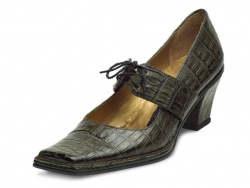Difference between revisions of "Alligator leather"
| Line 20: | Line 20: | ||
Since the entry into force of the [[CITES - Convention on International Trade in Endangered Species of wild fauna and flora|CITES (Convention on International Trade in Endangered Species of wild fauna and flora)]] in the 1970s, alligator stocks in the USA and China have risen again after they have been reduced for a long time by hunt for leather production. | Since the entry into force of the [[CITES - Convention on International Trade in Endangered Species of wild fauna and flora|CITES (Convention on International Trade in Endangered Species of wild fauna and flora)]] in the 1970s, alligator stocks in the USA and China have risen again after they have been reduced for a long time by hunt for leather production. | ||
| − | In the United States, the population has risen from approximately 100,000 to 1.5 million alligators. In addition, 500,000 alligators are kept in breeding stock in the USA. Each year, approximately 33,000 hides of free-ranging alligators are processed in the USA and approximately 275,000 | + | In the United States, the population has risen from approximately 100,000 to 1.5 million alligators. In addition, 500,000 alligators are kept in breeding stock in the USA. Each year, approximately 33,000 hides of free-ranging alligators are processed in the USA and approximately 275,000 of breeding alligators. 85 percent of them come from Louisiana. |
Revision as of 19:08, 29 October 2016
Contents
Alligator leather
Alligators do not belong to the real crocodiles, but share with these same animal family. Compared to crocodiles there are numerous anatomical deviations, as also mice and rats are only superficially similar. The metabolism of alligators is much slower than that of crocodiles, which gives them an approximately twice as long life.
Alligator leather bag from approximately 1940 and a bag with integrated head of the alligator from the 50's.
Alligators are located in the marshes, lakes and rivers of North America (Mississippi) and China. Chinese alligators usually measure 1.8 meters in length, while the American variant can reach six meters.
Since the entry into force of the CITES (Convention on International Trade in Endangered Species of wild fauna and flora) in the 1970s, alligator stocks in the USA and China have risen again after they have been reduced for a long time by hunt for leather production.
In the United States, the population has risen from approximately 100,000 to 1.5 million alligators. In addition, 500,000 alligators are kept in breeding stock in the USA. Each year, approximately 33,000 hides of free-ranging alligators are processed in the USA and approximately 275,000 of breeding alligators. 85 percent of them come from Louisiana.
Leather shoes made of alligator leather from Jacob, F. Schuhe.
Caiman leather - Caiman skin
Caimans are a subspecies of the alligators and are mostly found in South America and partly in Central America.
Caiman from the Pantanal in Brazil.
Skin of the Cayman.
Video about leather of different animal species
Leather of different animal species - Exotic leather
Other exotic leather
- Alpaca fur
- Antelope leather
- Armadillo leather
- Bird leather
- Bull testicles
- Camel leather
- Carpincho leather
- Cat fur
- Chicken leather
- Crocodile leather
- Dog leather
- Donkey leather
- Elephant leather
- Fish leather: Eel, shark, salmon, moray eel, stingray and many others
- Frog leather - Toad leather
- Giraffe leather
- Hippo Leather
- Horsehide - Horse leather
- Kangaroo leather
- Llama Fur
- Lizard leather
- Ostrich leather
- Pangolin leather
- Peccary leather
- Rumen leather
- Sealskin leather
- Snakeskin
- Turtle skin
- Walrus leather
- Yak leather
- Zebra hide














 a kotori web solution
a kotori web solution